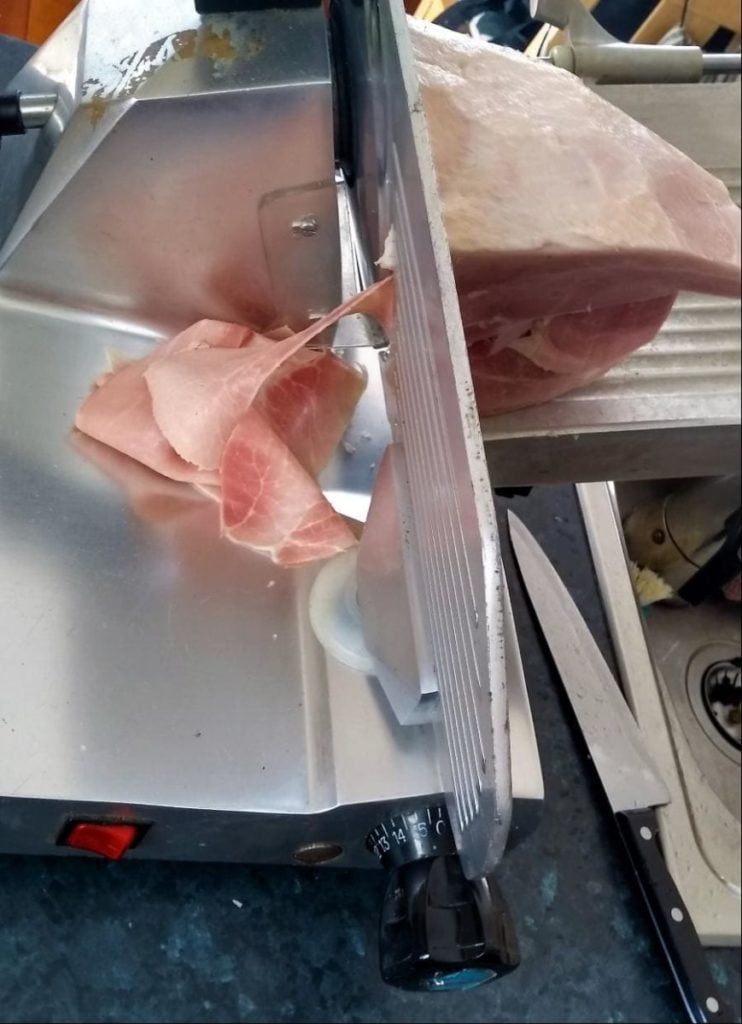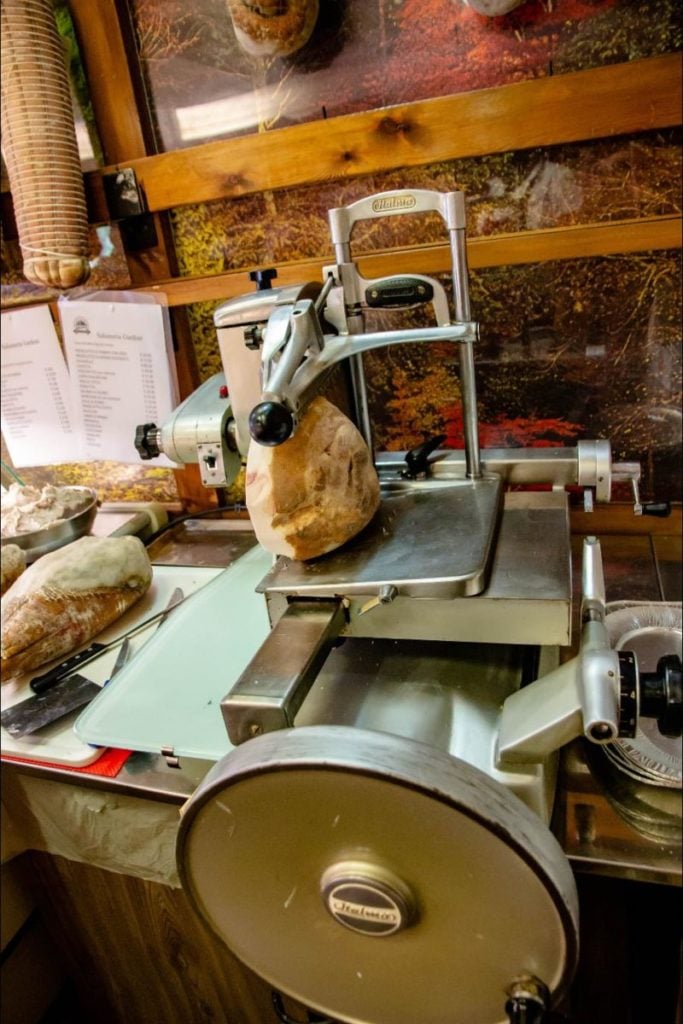Deli slicers are handy, but what I have found it, for my application weight has a big impact.
If you have ever been to the deli, then you have likely stood fascinated at how quickly and easily the deli slicer is able to slice through a large cut of meat. You might want to bring this device into your kitchen but question its practicality wondering how easily you could move it around.
Buying a whole ham and slicing it yourself is such a time and money saver in my opinion!
How Much Does a Deli Slicer Weigh? There are a few different types of deli slicers including manual, automatic, and commercial-grade deli slicers. In general, thin-slicing deli slicers weigh over 20lbs/10kg with commercial-grade slicers often weighing over 100lbs/50kg. Thick-slicing domestic-use deli slicers weigh under 20/10kg lbs and are portable in your home.

With so many different uses for deli slicers, it can be understandable that you would want to know how practical it is to bring this device into your cooking space.
For my main use, which is wafer-thin slicing, I’ve found certain characteristics are key in the slicer, weight is one of them.
So, whether you are looking for a lighter device or one that stands firmly in place, there are plenty of options for you. Let’s take a closer look.
I’ve done the homework for you, so here is a of deli slicers and the different weights. Under 20 lbs models below are not suitable for wafer thin-slicing, I’m talking transparently see-through.
But they will suit at home slicing things like cheese, bread, and thicker cuts of ham and meats.
| Deli / Meat Slicer | Uses | Weight | Blade Size |
| KWS 12″ Premium | All Rounder – Ham, Cured Meat, Cheese, Thin Cut | 60 pounds | 12″ |
| Compact KWS (Red) | Compact All Rounder – Ham, Cured Meat, Cheese, Thin Cut | 27.5 pounds | 6″ |
| Chefman Electric Deli | Bread, Vegetables, Thick Cut | 14.82 pounds | 8.6″ |
| OSTBA Deli Food Slicer | Bread, Vegetables, Thick Cut | 8.64 pounds | 7.5″ |
We are talking $500ish for over 20lb and $100ish for under 20lb deli slicers. A $100 slicer will not do charcuterie slicing effectively.
Different Weights for Deli Slicers
Deli slicers make many processes in your home kitchen much more efficient. Particularly, you can slice through a delicious steak, salami link, or even onions and other vegetables much more quickly and easily with a deli slicer.
Whether it is manual, automatic, or commercial-grade, the tools will be incredibly satisfying once you get the hang of working with them.
Thin-Slicing Deli Slicers
When you begin to take a closer look at various deli slicers, you will find that the thinner the device is able to slice your meat or other types of food, the more the slicer will likely cost as well as weight.
Though, I’ve found a few that can do the job and are hundreds rather than thousands of dollars to invest in.
This is because, in order to get your meat thinly sliced, the device must be capable of producing a quick deliverance of a swift, sturdy blade through your meat – with precision.
Often, this means that you will see that thin-slicing deli slicers weigh much more than those that are thick-slicing. Thin-slicing deli slicers most often weigh more than 20lbs and can range even higher.
These products are durable and can greatly improve your slicing capabilities- especially if you use this type of feature regularly.
So, if you are looking to bring a thin-slicing deli slicer into your home, you will most likely want to prepare space on your counter that can house the deli slicer semi-permanently.
This will make the process of slicing your meat and other food items much more efficient as you will not have to go through the setup process and can quickly get to slicing your meat.
Thick-Slicing Deli Slicers
Thick-slicing deli slicers, on the other hand, weigh far less than their counterparts. More often than not, a thick-slicing deli slicer is not going to appear metal or more plastic. It does not mean that it cannot get the job done well.
Instead, this means that the device does not require the same type of precision of the blade and heavy-duty deli slicing components.
Because of this thick-slicing deli slicers can weigh as little as 8lbs and can be convenient kitchen tools that can more easily be moved about.
When you picture a lightweight deli slicer, you can likely imagine that this is going to be less sturdy and far less cumbersome. However, this does not mean that you cannot still find a high-quality deli slicer at a low weight.
Often, these types of deli slicers are used for cheeses, vegetables, and fruits along with various types of meat.

For example, you could use a thick-slicing deli slicer to prepare a savory steak, but you can also generally narrow down the cut to be able to work well for salami and other types of meat choices.
Just be sure to pay attention to the product specifications when you check the reviews on the device to know if it will be the right fit for your deli slicing needs or not.
Commercial-Grade Deli Slicers
Unless you are more skilled and dedicated to the process of slicing meat, then you will likely not need a commercial-grade deli slicer in your home.
More often than not, an automatic deli slicer can do the trick for most people who use this device’s basic functioning. However, this obviously does not apply to all people and should be considered in the conversation.
Commercial-grade deli slicers are not likely to be moved frequently once they have found their spot in the kitchen (or the deli). They can weigh upwards of 60 lbs and are capable of slicing meat ever so finely.
They are also designed with motors for long running times.
This type of deli slicer is what you dream about as you witness your local butcher using it to prepare delicious slices of meat for you to take home in delight.
While these products are heavy, they are worth their weight in the capabilities that they bring into the picture.
Readily able to slice down your meat selection into finely sliced deli slices can make the process efficient and even fun. But, unless you plan to use this daily, you likely will not need to go with the commercial-grade route.
How Do I Choose a Deli Slicer?
As you compare the product dimensions of various deli slicers on the market, you might be curious about which one you should bring into your home.
With manual and automatic deli slicers, different dimensions, a wide range of costs, and optional features involved, it can be tough to decide.
To choose a deli slicer for home use, be sure to check for the thickness of cut that the slicer can achieve, manual or automatic slicing, the cost, what types of food the slicer can be used with, the regularity and longevity of use that you intend for the device, and the size of the blade.
Let’s take a closer look.
- The thickness of Cut. When you are deciding on a deli slicer, you will want to make a special note of which ones are going to cut at the range that you prefer.
This matters tremendously as it will become the entire point of the device- to slice your meat and other types of food.
If you are looking for a deli slicer that can cut your steaks evenly, then choose one that has a wider cut allowance. Contrarily, if you want to create thin slices of meat for your sandwiches, then you will want to find a deli slicer that ranges in a much narrower cut.
Some options on the market will have a wide range, so be sure to check for what you would like to include in the range. Then, you can narrow down your quest by quite a bit.
- Cost. Of course, when choosing the right deli slicer for you, you will have to consider the cost that you are willing to work with.
Be sure to include the savings that will come from being able to purchase a larger slice of meat at the deli and cut it at home as compared to purchasing pre-sliced steaks, for example.
These savings could affect your decision on choosing to invest more up-front in a high-quality deli slicer for your home use.
- Types of Food. While some deli slicers will work with everything from onions, cucumbers, links of salami, cheese, and bread, others are more narrow in what they can be used for and are mainly intended for meat.
If you plan to use the deli slicer for more than one type of food, just do a quick review to ensure that you will be able to.
- Regularity and Longevity of Use. How frequently you plan to use your deli slicer will matter in that you will want to spend a little more to purchase a high-quality deli slicer if you intend to use it regularly.
However, if you will only use the device occasionally, then you might be ok with choosing a lightweight option.
But, if you plan to use this kitchen tool for longer than a year or two, then choosing to invest in a durable product is worth it.
- Serration of Smooth Blade Serrated blades are for general-purpose vegetables and thick ham, you won’t get wafer thin slicing with a serrated blade though
- Size of the Blade. Not only do you need to pay attention to how thick the deli slicer will be able to cut your meat (among other types of food), but the size of the blade changes what you will be able to use the device for in the first place.
For example, a 6”-12” blade will allow for a moderately sized piece of meat to slide through.
I’ve done some analysis on slicers that are commercial/domestic hybrids, for my main task of wafer-thin cured meats slicing they do a fantastic job! Some are quite compact (still a bit of weight though). Check out the post I wrote on these here.

Tom Mueller
For decades, immersed in studying, working, learning, and teaching the craft of meat curing, sharing the passion and showcasing the world of charcuterie and smoked meat. Read More
